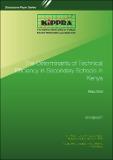| dc.description.abstract | Kenya has made tremendous progress towards access to basic education, which encompasses pre-primary, primary and secondary education. This is manifested in the increasing demand for secondary school education. Secondary school enrolment increased from around 1.4 million students in 2013 to 2.3 million students in 2014. This can be attributed to fees subsidy in secondary school education, strong government support for infrastructure and increased teacher staffing. In spite of these efforts, transition rate from primary to secondary schools is still low with about 2.1 million students who are supposed to be in secondary education missing this level of education. The consequence of this is that opportunities for accessing higher education will be missed, implying low access to skills development. In addition, school performance as measured by exam test scores has not improved over the period since the secondary school fee subsidy was implemented. This poor performance could be attributed to resource constraint, wastage of public funds, and inherent inefficiencies in secondary schools. This study examines the determinants of technical efficiency in secondary schools in Kenya and gives policy recommendations. The key findings of the study are: i) there exists wide variability in performance and enrolment of students across secondary schools in Kenya; ii) secondary schools are inefficient and could improve their outcomes by 37.3 per cent at current resource levels; iii) secondary schools have 26 per cent unused capacity; iv)larger schools and urban-based schools are more efficient compared to smaller schools and rural-based schools. Public schools have a negative effect on efficiency. | en |

